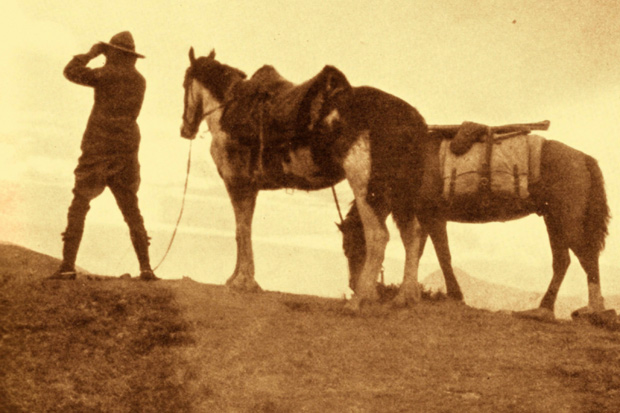Aimé Tschiffely was what I have seen in other contexts called a ‘doublehard bastard’. In the middle of the 1920s, this Swiss-born schoolteacher at the age of 30 feared that he was getting stuck in a groove and that he wanted ‘variety’. So he set out on a solo horse-ride from Buenos Aires to New York City.
Tschiffely wasn’t even much of a horseman at this point. But he had the notion that the wild Criollo horses of Argentina — descendents of the Spanish horses transported to the continent by the Conquistadors in the 16th century and brought to excellence by their survival in that unforgiving environment in the centuries since — were the hardiest horses for long riding in the world. Everyone else thought he was mad.
But off he set, and this volume — originally published in 1933 — describes his journey: 10,000 miles over some of the roughest country imaginable. Those who thought him mad would seem to have had a point. But he made it — at least to Washington DC; he scrupled that going on to New York might look like showing off — and in the manner of its telling, Southern Cross to Pole Star speaks of sanity: of pragmatism, fastidiousness and determination. Also of being doublehard. An introduction by the explorer Robin Hanbury-Tenison, which is mostly about Robin Hanbury-Tenison, testifies to the book’s influence on long riders ever since.
It’s quite a piece of work. Tschiffely made no claims for himself as a writer — the keynotes of his tone throughout are modesty and amiability — but that does him down: he tells his story with great lucidity, occasional shafts of humour and a decently restrained note of anthropological curiosity. Here he observes the crowd, for instance, waiting for a movie to begin in Cuzco:
The young caballeros, who had carefully plastered down their oily black hair, were wearing their very best clothes for the occasion and preferred to stand along the walls, from where they had a better view of the señoritas, who nervously and self-consciously fingered their dresses. If a young lady had the audacity to cast a quick glance around and happened to see the longing and lingering eyes of a gentleman acquaintance of hers who looked at her as a forsaken lover looks at the moon, she would greet him with a slight nod and a quick, nervous smile would flash over her face, and then all the chaperones would stiffly turn their heads like prairie owls and look at the daring young fellow, who would finger his best necktie and loosen his collar as if he were choking. This is South American courting. The poor people, chiefly men and boys, were perched up on a wooden gallery, and from there their bare feet were dangling down like dummy legs in the window of a manufacturer of artificial limbs.
Tschiffely’s attention passes freely from the landscape to natural history, local customs and superstitions, architectural relics and anything else that falls into his field of vision. He’s smart and curious. Of introspection, he gives us little. His interest in the womenfolk is of the gallant-compliment type. Yet he’s not priggish. He seeks out an opium den (he doesn’t much like being stoned, he decides) and allows himself to be taken to a brothel, where one of his story’s many knife-fights breaks out.
He acquires a connoisseurial eye for shrunken heads. He isn’t squeamish about the way the Bolivian corn-beer chica is made, which begins with a team of peasants chewing up the corn and spitting it out into a bowl; though he expresses a preference for the Panamanian version (‘this is done by the girls about to be married, whereas anybody with or without teeth does it thus in Bolivia’).
Happy to turn his fists and even his guns on those he regards as rogues (among them the ‘intoxicated negro’ who attacked him with a machete), he is to all the many who receive him hospitably the very spirit of courtesy. Indeed, as he enters the final third of his journey, his own celebrity becomes the problem: everywhere he shows up, they throw him a fiesta. Invariably desperate for a kip, he’s too polite not to stay up and be celebrated until the last drunken local passes out.
He is amiable — and yet somewhat detached. The strongest emotional bonds he forms are not with the locals he occasionally enlists as guides for sections of his journey, but with his horses: his reunion with his horse Gato who, lamed, had to be sent ahead by train, mists the eye. When he witnesses the rape of a 12-year-old Indian girl he finds it ‘distasteful and revolting’, but his response to animal cruelty feels visceral and personal.
From town to town he passes, paying his respects to the local autoridades, finding his horses Mancha and Gato what fodder he can and bunking down wherever somewhere horizontal presents itself. His saddle was more often than not his pillow. He ate monkey, iguana, raw onions (sovereign for altitude sickness, apparently), as well as a lot of rice, yucca, beans and tortillas (when there was anything to eat at all). Parasites burrowed under his toes to lay eggs, little red ticks covered him, and his belt rubbed him blood-raw.
What did he have to overcome? What didn’t he? Rivers in torrent, drunken locals, quicksand, vampire bats, bandits, perilous mountain passes, altitude sickness, malaria, insects and snakes of all varieties, murders and rapes, burning weather, freezing weather, sleep deprivation, unceasing hunger — even, at the end of his journey, the near-fatal attentions of reckless motorists. At one point, he notes: ‘Prospects for crossing Nicaragua were none too rosy, for a revolution was centred in the very parts I had to ride through.’
A coda to the story, dropped in incidentally, is that if he hadn’t lingered in Washington to give a lecture to the National Geographic Society he and his horses would likely have been aboard the Vestris, which sank. Doublehard — and lucky.
His stoicism is remarkable. Only in passing will he mention ‘before this, I had been robbed on several occasions’. Matter-of-factly, he reports that a malarial attack — ‘even the roots of my hair hurt’ — is especially beastly ‘when one has to ride all day and sleep on the floor of a municipal building’. Still, on to the next thing.
What was it all for? As I say, he’s not one for reflection. But atop the Costa Rican mountain Cerro de la Muerte, 11,500 feet above sea level, Tschiffely sits down on the ground for a cigar. It’s freezing cold and the moon illuminates the mists below. The Pacific is on one side and the Atlantic is on the other:
My thoughts wandered back to my boyhood and to the school bench for which I had an inborn dislike. Then I recalled some incidents of my boisterous age and chuckled to myself. As I tried to penetrate the infinite distance, pictures of city life appeared before me, the strife for wealth and fame, the hurry and worry of mankind, some rising, others falling, foolish pleasures, the struggle of humanity, and then I came back to reality — where was I? — strange coincidence. La Muerte — Death. When the first purple streaks on the horizon announced the arrival of a new day I returned to the shelter to prepare coffee. The horses followed me in hopes of something good and, although we had none to spare, each one received a good chunk of unrefined sugar which they munched until their mouths foamed and dribbled.







Comments